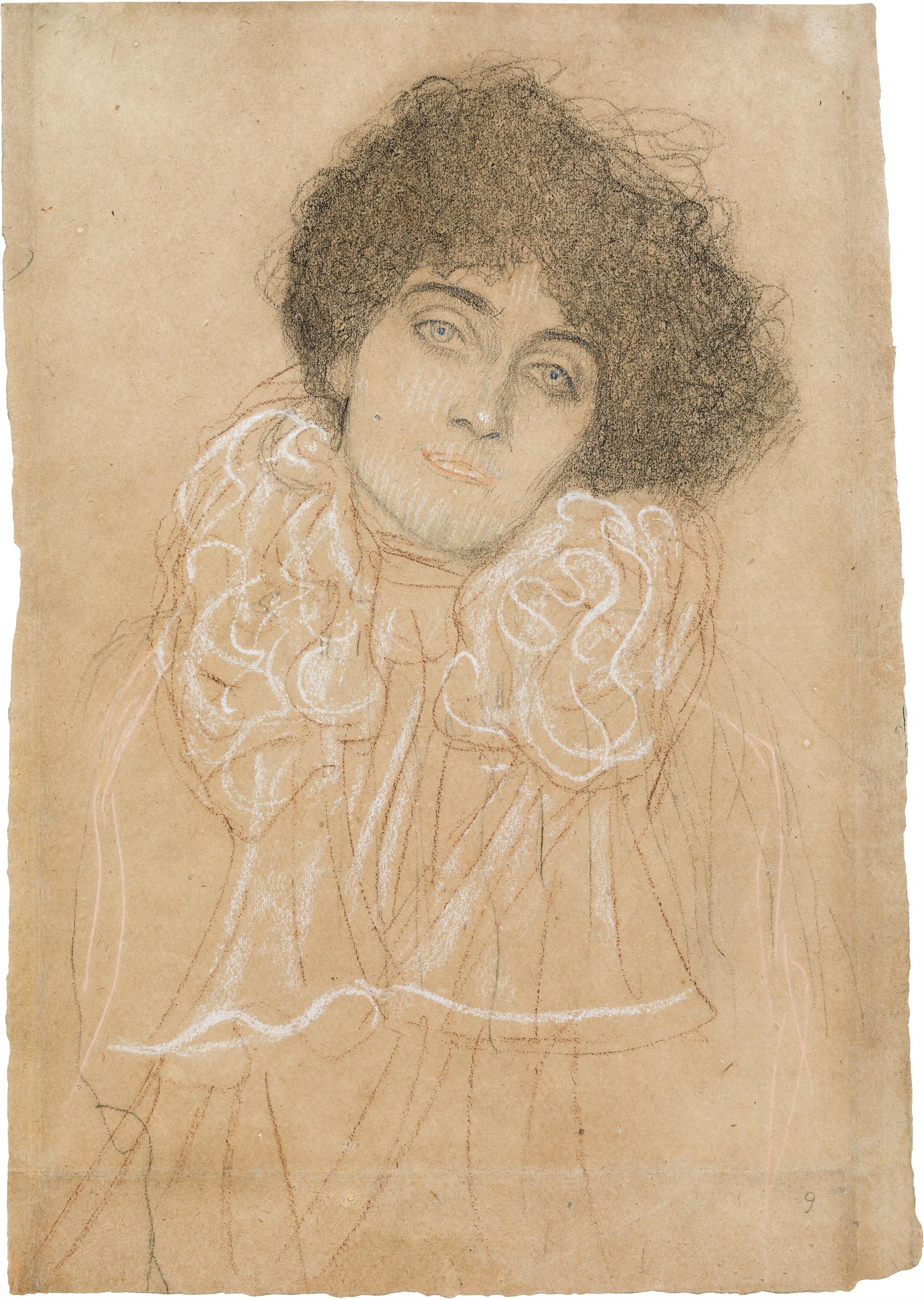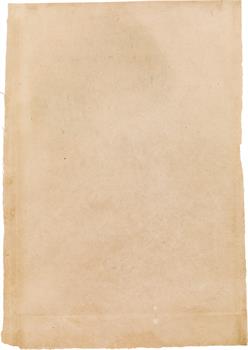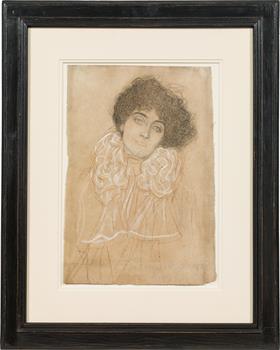0426
Gustav Klimt
(Wien 1862 - 1918 Wien)
„Lady's bust portrait from the front“
1897/98
brown, black, red and blue chalk on paper, heightened with white
45 x 32 cm
Provenance
Dr. Anton Loew, Vienna (acquired directly from the artist);
Gertrud Baruch von Felsöványi, née Loew, Vienna;
Gustav Ucicky, Vienna (acquired around 1941);
Ursula Ucicky, Vienna (inherited from Gustav Ucicky in 1961);
Klimt-Foundation, Vienna (donated by Ursula Ucicky in 2013);
Community of heirs after Gertrud Loew-Felsöványi (based on a restitution agreement with the Klimt-Foundation)
Exhibition
2012 Kammer am Attersee, Gustav Klimt Centre, opening exhibition;
2018 Vienna, Literature Museum, Berg. Wittgenstein. Zuckerkandl. Central Figures of Viennese Modernism, 22.03.2018-17.02.2019, cat. illustration p. 272
Literature
Alice Strobl, Gustav Klimt. The drawings 1878-1918, addendum, vol. IV, publisher Galerie Welz, Salzburg 1989, catalogue raisonné no. 3318, fig. p. 69 (there dimensions of the former passe-partout aperture: 41 × 28.5 cm);
Olga Kronsteiner, Trockenübung am Attersee (En: Preliminary exercise at Lake Attersee), in (the daily): Der Standard, 8 November 2013 (incl. depiction);
Olga Kronsteiner, Die andere Definition von schön (En: The other definition of beautiful), in (the daily): Der Standard, 26 June 2015
We thank Dr. Marian Bisanz-Prakken for her kind support.
Estimate: € 200.000 - 400.000
Auction is closed.
Refinement and mystery: modern female portrait drawings by Klimt
Among Klimt's drawings, the autonomous female portraits from around 1895 onwards are an independent, frequently represented genre. In contrast to the female models in his famous portrait paintings, most of the women depicted in the form of bust or half bust portraits are largely unknown. In these intimate, often highly refined works, the artist was not primarily concerned with the women themselves, but with the subtle exploration of types, characters, and mood values. This type of depiction flourished particularly during the founding period of the Secession (1897/98). The portraits shown here (cat. nos. 425 and 426) were also made during this phase of radical change. These naturally differ from the spontaneous studies with which Klimt prepared his first modern portrait of Sonja Knips at the same time (1898, cf. cat. no. 428).
Both portrait drawings stand out through the respective emphasis of their profile and frontal view. Within his modern symbolist vocabulary, the female profile with the lowered gaze is a most frequent metaphor for melancholy and introspection. Characteristics such as mask-like frontality and staring eyes can be compared with his programmatic allegories "Tragedy" (1897), "Pallas Athene" (1898) or "Nuda Veritas" (1898/99). The hypnotic effect of this type of face refers to the great significance the Belgian symbolist Fernand Khnopff had for Klimt at the time.
Klimt's autonomous female portraits can be seen as a tightrope walk between melancholic "soul art" and refined, often fashionable aesthetics. In the early Secession period, many of these depictions stand out due to the unusual use of coloured chalks ranging from the soft pastel technique to the finest line structures. The drawings discussed here also bear witness to these experiments. In the profile portrait, the brown smudged lower layer of the hair is closely overlaid by parallel flowing black lines and white accents. All the more transparent is the delicately lightened face, in which the white hatchings seem to blend in with the linear sweep of the hair.
In the frontal portrait, the mask-like flatness of the face is additionally underlined by fine white vertical hatching. Like an island, this is surrounded by the lush, finely structured hair and the broad, flowing white chalk lines of the folded shawl. Klimt sketches the clothing with brown chalk he rarely ever uses. In the face, the magical effect of the eyes - especially the pupils - is considerably enhanced by the precise accents of the blue chalk. The shadow areas are also dotted black and blue, while the red of the slightly open mouth shines sensually.
Klimt's differentiated use of colours is forward-looking as is his practice of structures effectively played off against each other. A few years after their creation, both portraits together with four other drawings became part of Koloman Moser's interior design for the bedroom of the newlywed couple Eisler-Terramare, which has been identified in 2007. The five surviving sheets in this series show a coherence of motifs and style. Perhaps the motto "the beautiful Viennese", as Emil Pirchan called two of the drawings of the series depicted in his Klimt monograph in 1942 - including our profile portrait – even reaches back to Klimt. In any case, the function of the drawings framed by Moser as part of a secessionist work of art illuminates the high significance of the medium of drawing in this milieu. While the catalogue raisonné of Klimt‘s drawings still shows the previous condition of the drawings, which at some point were newly framed and folded inwards, they now can be admired again in their original size after their restoration (2016).
(Marian Bisanz-Prakken)



